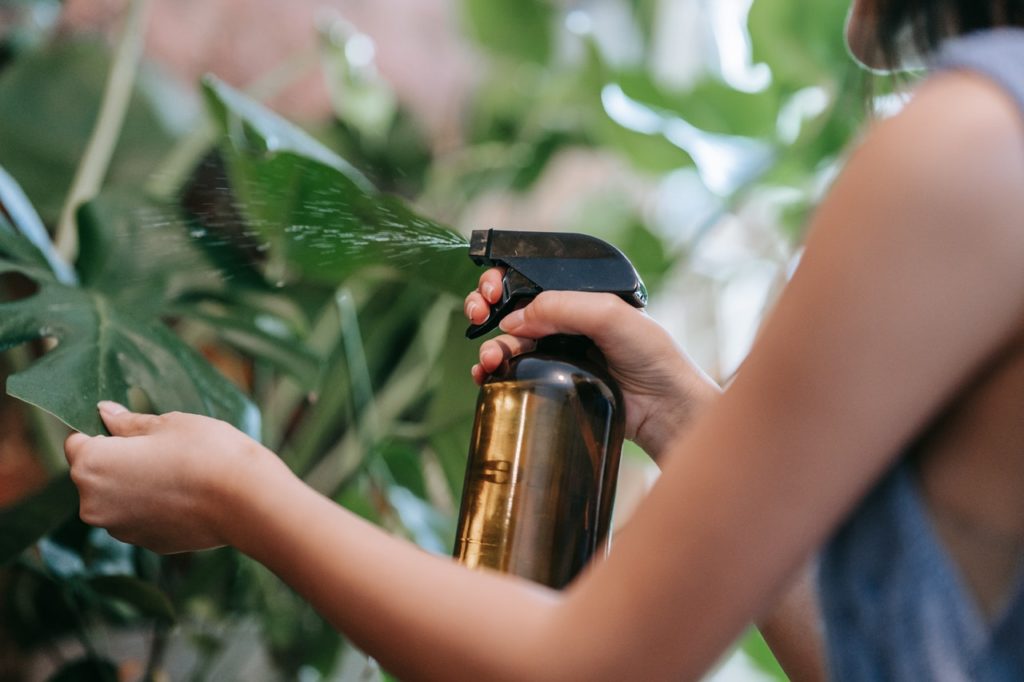
I learned this today. A spray bottle works by breaking the liquid up into tiny droplets using a pump and different kinds of nozzles.
Modern spray bottles work slightly differently to older spray bottles. The first kind of spray bottles used a rubber bulb and an atomizer nozzle. They were invented by an American called Dr. Thomas DeVilbiss in about 1850. He was trying to find a way to spray medicine on the backs of his patient’s throats. Dr. DeVilbiss used a rubber bulb and a glass bottle of liquid. By squeezing the rubber bulb, he produced a fast stream of air. This air passed across a vertical tube in the bottle of liquid. The fast flowing air sucks up the liquid from the glass tube and the liquid is dispersed as small droplets in the stream of air.
The reason this works is because of the Venturi effect. The Venturi effect was discovered by Italian physicist Giovanni Battista Venturi. Liquids are incompressible. When a liquid is forced through a smaller space, its velocity must increase because the same amount of mass and energy is in a smaller space. This increases the velocity of the liquid. The fast flowing air passing across the top of the glass tube creates a low pressure zone, which draws the liquid out of the tube and into the air flow. Once in the air flow, the liquid is broken up into tiny droplets and sprayed out as a fine mist.
There were also spray bottles that had a glass bottle and a metal pump not too dissimilar to the type of pump that is in a modern spray bottle, but I couldn’t find when and where these were invented.
Modern spray bottles work differently to this. Modern plastic spray bottles were invented by Dr. Jules Montenier in 1947. He invented a spray on deodorant. During World War 2, tremendous advances in plastics had occurred and plastic bottles and parts were now a possibility. However, his bottle didn’t have a trigger. You created the spray by squeezing the bottle and the liquid was forced through tiny holes, becoming a mist. In the 1960s the trigger was invented.
So, how does a modern spray bottle work? There is a bottle to hold the liquid. Until plastics became more durable, this used to be glass. The pump and the trigger would be replaced as they broke. These days, the bottle is plastic as well.
There is a pump on top of the bottle. This is known as a positive displacement pump. When the trigger is pulled, a spring pushes it back out. This creates a vacuum inside the pump that sucks fluid up the pipe out of the bottle. The trigger always moves the same distance so the same amount of fluid is sucked up each time.
The pump also needs to have two one way valves. One needs to stop the liquid flowing back into the bottle and the other needs to stop air flowing in through the nozzle. This is done by using a ball and a spring. The ball seals the hole that the fluid comes through or seals the nozzle. When the trigger is pulled and liquid is forced through, this pushes the ball back and passes through the hole. When the liquid has passed, the pressure of the liquid on the other side of the bull, with the aid of the spring, pushes the ball back and seals the hole.
Once the liquid has been drawn up by the pump, it needs to be converted into a spray. This is done by forcing it through the small hole of the nozzle at high pressure. The hole is so small that the liquid is forced into a very thin stream. Because it is under such high pressure and has such a high velocity, it is broken down into droplets when it comes into contact with the air. Then the one way valve behind the nozzle closes off after all of the liquid has gone through and stops the air getting back in.
There are other types of nozzles for different purposes. Some mix two liquids. Some atomize the liquid by having it come into contact with a large surface area as it exits the nozzle. Some have many holes and some have angled holes. Each one is for a different purpose.
So, spray bottles work by forcing the liquid through a very small hole at a very high pressure. And this is what I learned today.
Photo by Sasha Kim: https://www.pexels.com/photo/person-watering-the-plants-9413659/
Sources:
https://www.lhlotionpump.com/news/how-does-a-spray-bottle-work.html
https://alexanderell.is/posts/check-valve/
https://www.bwbtech.com/post/what-is-the-venturi-effect-and-how-does-it-work-in-a-nebuliser
https://perfumeatomizers.blogspot.com/2013/09/early-atomizer-history.html
https://en.wikipedia.org/wiki/Pump#Positive-displacement_pumps
https://en.wikipedia.org/wiki/Spray_bottle
https://physics.stackexchange.com/questions/79039/how-does-an-atomizer-work
https://medium.com/@imgennari22/the-spray-bottle-e16b965230f2
https://careertrend.com/list-7494144-list-simple-machines-used-agriculture.html
https://en.wikipedia.org/wiki/Spray_nozzle
https://en.wikipedia.org/wiki/Bernoulli%27s_principle
https://en.wikipedia.org/wiki/Venturi_effect
https://en.wikipedia.org/wiki/Atomizer_nozzle
https://homesteady.com/13419502/how-does-a-spray-bottle-work
